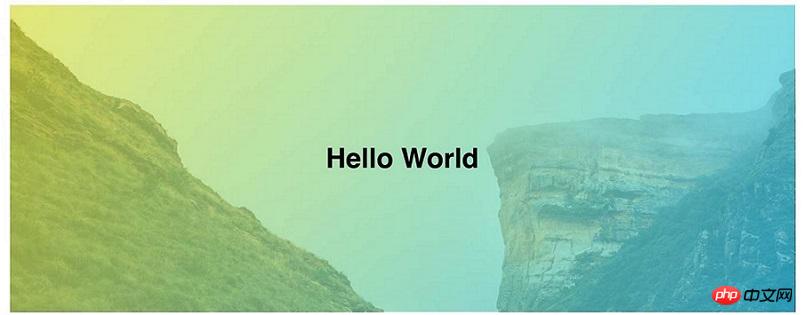
In web design we find that more and more text will be placed on top of images. Usually, this is not easy to operate because images have dynamic colors and lighting, and most of the text is one color. This is generally not good for readability and accessibility and can make the text look less clear.
This means that if we want to introduce an overlay between an image and text, then sometimes this will darken the background image for easier reading. We all need a simple CSS technique to introduce this kind of overlay. (Recommended course: css3 video tutorial)
Since I don’t want to introduce new tags for decoration, we will use the CSS ::after pseudo-element.
We can achieve this through the following process.
1. Create the simplest HTML for the area you need
2. Use the ::before or ::after element to create a background image
3. Use z- Problems caused by modifying absolute positioning of index
4. You can try to use mix-blend-mode to achieve some interesting effects
Step 1: What you need is without any redundant marks Background Image
In the background image, all we really want is the background image to act as a container and whatever content the background image needs to contain.
<section class="banner">
<h1>Hello World</h1>
</section>
In this example, we only use a section container and an
There is a little "magic" here that can increase the height of the background image and the center position of the text. This is not important for the scope of this article, but if you are curious, you can try it yourself.
Step 2: Use::after to dynamically add overlay elements
The ::before and ::after elements provided by CSS have powerful functions for us. Add style content to pages that shouldn't affect markup.
By applying the ::before or ::after elements, you can insert dynamic elements into the DOM before or after the selected element's children.
An important note is that all pseudo-elements require the content display CSS property. Although in our example, content is just a blank string.
.banner::after {
content: ""; // ::before and ::after both require content
position: absolute;
top: 0;
left: 0;
width: 100%;
height: 100%;
background-image: linear-gradient(120deg, #eaee44, #33d0ff);
opacity: .7;}
Now we have a full width and height element. For this, we use absolute positioning because we don't want to affect the content flow of the document.
We use the opacity property to make the overlay slightly transparent.
In this example I chose a gradient effect, but you could use a simple background color or even another image to overlay.
3. Problems caused by using z-index to modify absolute positioning
If you look carefully, you will notice that something in this example is not completely correct. Our overlays cover not only the background image, but also the text within the background image.
By using absolute positioning, we are actually placing the overlay on top of the background image's stacking context. To solve this problem, the overlay and content need to be modified with z-index. I usually give the background overlay 1 and the content overlay 100.
.banner::after {
...
z-index: 1;
}
.banner > * {
z-index: 100;
}With that, we have a completed overlay.

4. You can try to use mix-blend-mode to achieve some other effects
For example, combine multiple elements as follows Mix together!
.banner::after {
/* opacity: .7; */
mix-blend-mode: color;
mix-blend-mode: hue;
mix-blend-mode: hard-light;}5. Source code
HTML:
<section class="banner">
<h1>Hello World</h1>
</section>CSS:
.banner:after {
content: ""; // :before and :after both require content
position: absolute;
top: 0;
left: 0;
width: 100%;
height: 100%;
background-image: linear-gradient(120deg,#eaee44,#33d0ff);
background-color: #333;
opacity: .7;
// mix-blend-mode: color;
// mix-blend-mode: hard-light;
// mix-blend-mode: hue;
}
.banner > * {
z-index: 100;
}
.banner {
position: relative;
min-height: 60vh;
background-image: url(https://images.unsplash.com/photo-1509473332032-f1ce823d92c4?ixlib=rb-0.3.5&q=85&fm=jpg&crop=entropy&cs=srgb&ixid=eyJhcHBfaWQiOjE0NTg5fQ&s=3e2410208e8f8a78e4aa3550fddfbb44);
background-size: cover;
display: flex;
}
h1 {
margin: auto;
}
body {
margin: 10px;
}The above is the detailed content of How to use the :after pseudo-element in CSS to implement an overlay of a background image?. For more information, please follow other related articles on the PHP Chinese website!